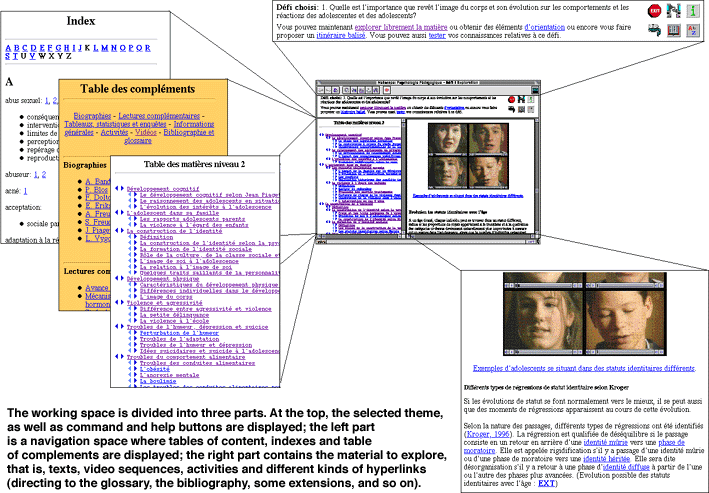A CD-ROM for Teaching and Learning Educational Psychology at the University?
by Gérald Collaud and Jean-François Perret
Universities are dealing with an increasing number of students. In Switzerland, the Swiss Scientific Council (Conseil Suisse de la Science) anticipates a 20% growth in the coming years. It is currently no more surprising to see students seated on the stairs or desperately trying to access the class room. Further, a growing part of these students are working part-time to pay the tuition fees, giving them less time to attend classes. This limited space and time situation forces universities to try to find new solutions. During the academic year 1996-1997, we made an attempt to deal with this concern. The material used for a one semester course (script, documents, research and videos) on 'educational psychology' (taught by professor J.L. Gurtner) was organised as a hypertext on a CD-ROM, and the time traditionally dedicated to the lecture was reaffected to workshops and seminars on specific aspects of the topic. Observations show rather encouraging responses from students.
The CD-ROM contains the course material on adolescence psychology corresponding to a one semester course of about 28 teaching hours. The students access the material using Netscape. We chose to use Netscape for the following main reasons. First, even for students with little or no computer literacy, Netscape is quite easy to use. Second, the course material is made of lots of texts and Netscape has been conceived from the beginning to display texts. Third, we were also concerned with costs. In an academic environment, Netscape is free of charge. Further, one can write HTML code with a simple text editor. Fourth, we wanted the students to be able to work with the CD-ROM on a PC or on a Macintosh. Netscape works on both platforms. Finally, we wanted to be able in the future to propose this course material on the web. Writing it in HTML will simplify this move.
From a didactic point of view, beside autonomous learning, the project also fosters problem-solving oriented learning. Five general problems (also called themes or leading questions) are proposed, challenging the students to collect relevant information in different sections of the material. A table of contents and an index, designed as hyperlinks, give access to the content. Beside mere free exploration, three level of guidance are provided. The lowest one consists in a video of the professor explaining the nature of the problem accompanied by written information about the relevant chapters of the script. At the second level, relevant sections of the script for the chosen challenge are automatically highlighted whereas the third level provides students with test-like questions which simultaneously help them to understand what parts of the material they currently master and direct them to the insufficiently reviewed sections of the material.
Observations and Conclusion
The evaluation of the experiment was conducted by the Centre for New Technologies and Teaching. Data were gathered through regular interviews and an anonymous questionnaire was sent out at the end of the semester. Interesting enough is the difference between the students' first impression, where half of them were anxious about the experiment, and their final judgement, where 81% of the students declared themselves as satisfied to highly satisfied with the experiment:
Globally, do you consider the experiment as:
- very satisfactory 23 %
- satisfactory 58 %
- unsatisfactory 13 %
- totally unsatisfactory 4 %
Another interesting observation can be made when comparing students' results at the final exam to their performances at the winter semester. Good learning was also evidenced, students' results being significantly higher for the summer than for the winter semester. One of the reasons of these results and of the acceptance of this new organisation certainly comes from the fact that replacing the traditional course with this new mixed procedure allows students to learn at their own pace.

This experiment is not only successful from the learner's point of view, but also from the University point of view since two third of the students where exploiting one of the advantages of the CD-ROM by working at home, thus freeing rooms for other classes.
Before going further in this direction however, it is essential to further analyse these new learning procedures (for instance, the combination of paper and computer) and to take into account students needs, particularly those regarding the interaction with the teacher and the time and support students need to cope with this new technologies.
Please contact:
Gérald Collaud - Centre Nouvelles Technologies et Enseignement,
University of Fribourg
Tel: +41 26 300 83 34
E-mail: gerald.collaud@unifr.ch
